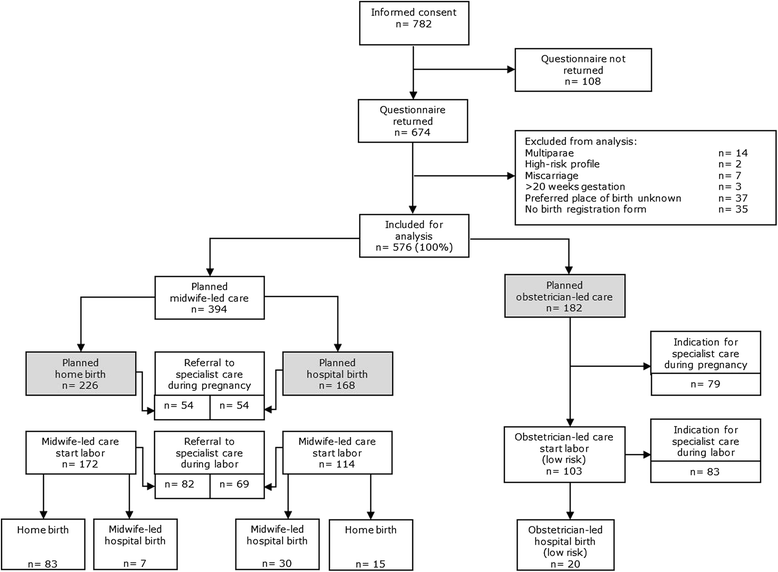The influence of preferred place of birth on the course of pregnancy and labor among healthy nulliparous women: a prospective cohort study
- PMID: 25884308
- PMCID: PMC4342224
- DOI: 10.1186/s12884-015-0455-x
The influence of preferred place of birth on the course of pregnancy and labor among healthy nulliparous women: a prospective cohort study
Abstract
Background: Most studies on birth settings investigate the association between planned place of birth at the start of labor and birth outcomes and intervention rates. To optimize maternity care it also is important to pay attention to the entire process of pregnancy and childbirth. This study explores the association between the initial preferred place of birth and model of care, and the course of pregnancy and labor in low-risk nulliparous women in the Netherlands.
Methods: As part of a Dutch prospective cohort study (2007-2011), we compared medical indications during pregnancy and birth outcomes of 576 women who initially preferred a home birth (n = 226), a midwife-led hospital birth (n = 168) or an obstetrician-led hospital birth (n = 182). Data were obtained by a questionnaire before 20 weeks of gestation and by medical records. Analyses were performed according to the initial preferred place of birth.
Results: Low-risk nulliparous women who preferred a home birth with midwife-led care were less likely to be diagnosed with a medical indication during pregnancy compared to women who preferred a birth with obstetrician-led care (OR 0.41 95% CI 0.25-0.66). Preferring a birth with midwife-led care - both at home and in hospital - was associated with lower odds of induced labor (OR 0.51 95% CI 0.28-0.95 respectively OR 0.42 95% CI 0.21-0.85) and epidural analgesia (OR 0.32 95% CI 0.18-0.56 respectively OR 0.34 95% CI 0.19-0.62) compared to preferring a birth with obstetrician-led care. In addition, women who preferred a home birth were less likely to experience augmentation of labor (OR 0.54 95% CI 0.32-0.93) and narcotic analgesia (OR 0.41 95% CI 0.21-0.79) compared to women who preferred a birth with obstetrician-led care. We observed no significant association between preferred place of birth and mode of birth.
Conclusions: Nulliparous women who initially preferred a home birth were less likely to be diagnosed with a medical indication during pregnancy. Women who initially preferred a birth with midwife-led care - both at home and in hospital - experienced lower rates of interventions during labor. Although some differences can be attributed to the model of care, we suggest that characteristics and attitudes of women themselves also play an important role.
Figures
References
Publication types
MeSH terms
LinkOut - more resources
Full Text Sources
Other Literature Sources
Medical
Research Materials


